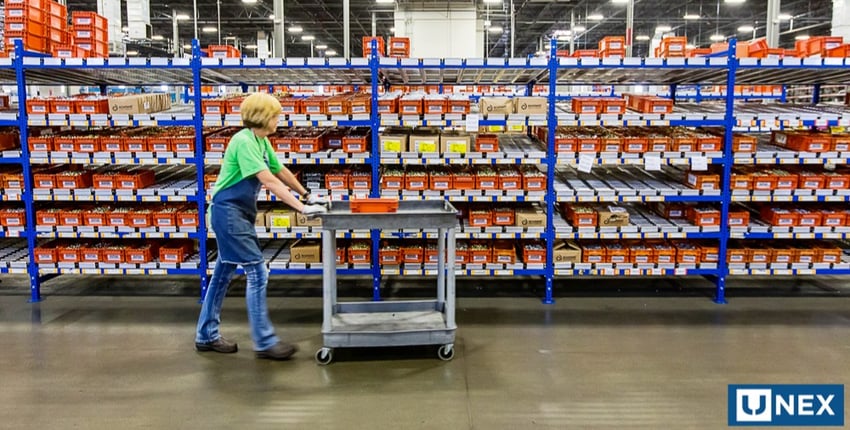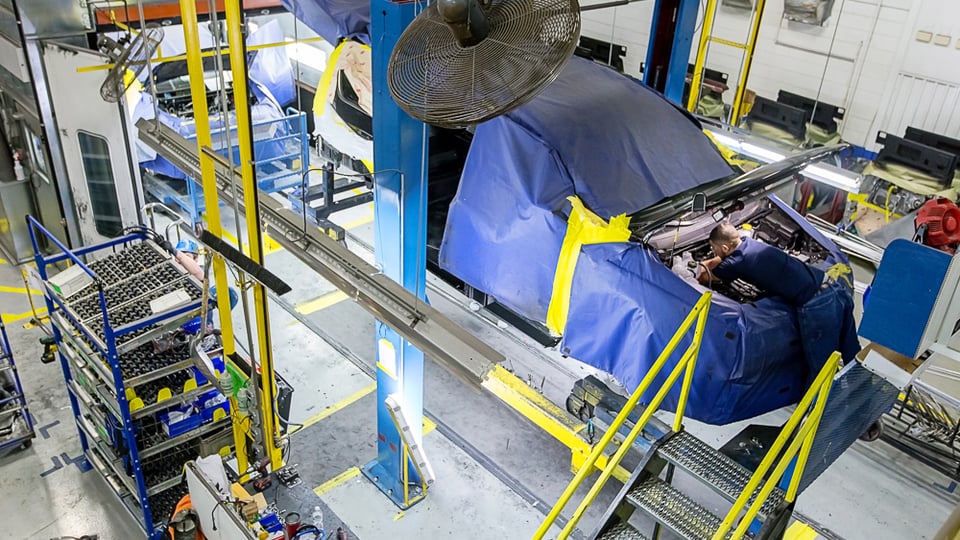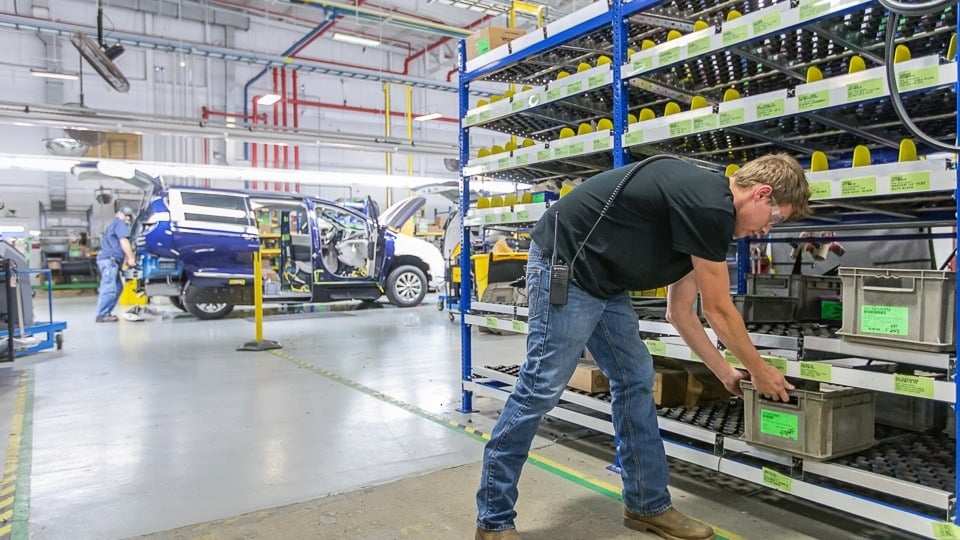Prepare for 2021 with these Four Manufacturing Trends

2020 was a year like no other. With forced shutdowns and new regulations from the pandemic causing unexpected production fluctuations and labor challenges, even a powerhouse like the U.S. manufacturing industry felt the impact. Manufacturers across the nation suddenly found themselves unable to obtain critical materials from global suppliers and managing less on-site employees to handle heightened consumer demand.1
In a 2020 survey conducted by the National Association of Manufacturers (NAM), they uncovered that 78% of respondents expect the COVID-19 outbreak to have a financial impact on the business and 53% anticipate a change in operations in response to the pandemic.2
Despite the challenges of 2020, manufacturers have proven their ability to adapt to the changing landscape. Recent data from NAM shows that manufacturing value-added output still increased from $2.054 trillion in the second quarter to $2.329 trillion in the third quarter, which was 1.7% below the record pace seen in the fourth quarter of 2019 ($2.370 trillion).
To recover from a turbulent 2020 and grow in 2021, manufacturers must streamline their operations, build more resilient supply chains, and keep a pulse on consumer expectations to better capitalize on post-pandemic opportunities and be prepared for future disruptions.3
Four Trends Shaping the 2021 Manufacturing Landscape
1. Manufacturers are Embracing Digitalization and Automation
According to Gartner, “disruption is driving digital transformation in the manufacturing industry.”4 COVID-19 is causing uncertainty in the industry and highlighting the need for transparency in operations and across supply chains. Because of this, manufacturers are pursuing smart technology such as advanced analytics, automation, robotics, artificial intelligence, and other advanced manufacturing technologies.5
“Manufacturers are set to experience five years of innovation in the next 18 months, as the current pandemic has demonstrated the need to adopt digital tools to automate processes, obtain real-time information, and create agile supply chains to comply with new restrictions.”
-VP of digital transformation for Rockwell Automation shared with Design News.6
Digitalization benefits extend beyond just automated processes, helping manufacturers to collaborate more effectively and productively in the wake of the pandemic. McKinsey explains how “An aging workforce, regionalization, and data proliferation are changing the composition of the manufacturing labor force and how work gets done—with the COVID-19 outbreak compounding some of the effects. As a result, manufacturers face an urgent imperative need to help less-experienced workers build knowledge and capabilities, and take advantage of data through collaboration.”
Digital collaboration can not only help to bridge the knowledge gap, but it also has the potential to unlock more than $100 billion in value by boosting productivity by as much as 30 percent in areas such as supplier maintenance.7
2. Localized & Diversified Supply Chains Will Become the New Normal
Beginning in the 1990s and accelerating with China’s inclusion in the World Trade Organization in 2001, many companies globalized their supply chains and embraced lean manufacturing techniques to reduce costs.8 However, recent political and pandemic turmoil has manufacturers looking to bring supply chains closer to home. A 2020 study by Gartner shows that 33% of supply chain leaders have either moved or plan to move operations out of China and 31% plan to “nearshore” some part of their production back to the Americas in 2021.9
“In 2021, the industrial manufacturing sector will take a page from the consumer-driven "farm to table" trend that has taken hold in the agriculture industry over the last decade, with a shift to localized production. This will primarily be driven by the threat of ongoing trade war/tariffs threatening global supply chains, encouraging manufacturers to move production activity closer to the customer.”10
-Forbes.
The stresses of 2020 and the pandemic have revealed weaknesses in the current supply chain and are prompting a redesign of how supply chain networks are built. And in the wake of related disruptions, 93% of manufacturing and supply chain professionals plan to focus on supply chain resiliency in 2021.11
3. The Pandemic Will Widen the Labor Gap Even Further
Manufacturing labor productivity has been sluggish since the Great Recession, which has been frustrating for the booming industry, averaging a decline of 0.2% from 2011 to 2019.12
To this day, labor productivity continues to be a major challenge for the industry. Especially during the pandemic, where capacity restrictions are complicating production processes and some manufacturing employees are getting paid while quarantining. To compensate for the dip in available labor, manufacturers have to find ways to increase productivity to not only pay workers more but also keep up with consumer demand and new health regulations.
Deloitte reports that the majority of manufacturing leaders seem unlikely to return to all the pre-pandemic work arrangements. Because of this, manufacturers are seeking ways to re-architect work, the workforce, and the workplace to manage disruption and uncertainty.
“In a post-election poll, 61% of surveyed executives are planning to develop a hybrid model for their production and non-production processes over the next three years.”13
As if navigating labor challenges from the pandemic wasn’t hard enough, manufacturers are also facing a qualified talent shortage as the current workforce is preparing to retire. According to the U.S. Census Bureau, nearly one-fourth of the manufacturing workforce is age 55 or older, a demographic reality that signals a labor shortage for the nation’s fifth-largest employer.14 In response, manufacturers are rethinking retention incentives to attract and retain quality talent to run their operations.
4. Sustainability Is Still a Priority for Manufacturers
The impact of COVID-19 has caused major economic disruptions, but the year also brought its share of natural disasters and shifts in consumer expectations that manufacturers have had to navigate. With all this taking place, it’s easy to assume that sustainability goals have fallen by the wayside. However, quite the opposite is happening. Many manufacturers are still prioritizing global sustainability goals like lower carbon footprints and more energy-efficient operations.
This is, in part, because commitments to more sustainable manufacturing have an impact on the public perception of the company.15 But also because it can have an impact on productivity and consumer happiness.
Recent research conducted by Capgemini Research Institute showed that 79% of consumers are changing their purchase preferences based on demonstrated sustainability by involved companie.16
As such, manufacturers are still finding ways to implement lean manufacturing practices and trim production processes to lower energy use, reduce emissions, and maintain more sustainable operations. Capgemini’s research revealed that 77% of surveyed companies say they are accelerating their investments in supply chain sustainability initiatives over the next three years.17
Enhance Manufacturing Operations in 2021 with UNEX
Many changes to manufacturing operations will happen well below C-suites. One easy change is to implement storage solutions to help streamline shop floor-level operations, allowing essential staff to do their jobs in a fast, flexible, and cost-effective manner.
UNEX’s scalable, versatile warehouse and assembly line solutions help manufacturers adapt to the rapidly-changing manufacturing landscape. They’re lean manufacturing solutions, which means that they help manufacturers create more value with fewer resources, which increases productivity, worker safety, and more. This ultimately saves money and boosts profit margins for manufacturing operations. They also integrate well with automated manufacturing solutions, providing a cost and energy-efficient partner to support digital transformation.
UNEX solutions are also sustainable and ready for immediate use. For example, UNEX conveyor solutions are gravity-powered, making them far more energy-efficient than automated and powered alternatives.
Looking to increase productivity and resiliency in your manufacturing operations? Connect with a space optimization specialist to learn more about how UNEX solutions can support your initiatives, or to request a quote.
Sources:
[1] https://www.mckinsey.com/business-functions/operations/our-insights/industry-40-reimagining-manufacturing-operations-after-covid-19
[2] https://www.nam.org/coronasurvey/
[3] https://www.manufacturingtomorrow.com/story/2020/12/how-the-covid-19-pandemic-accelerated-manufacturing-innovation-–-and-my-predictions-for-2021/16223/
[4] https://www.gartner.com/en/industries/manufacturing-digital-transformation
[5] https://www.mckinsey.com/business-functions/operations/our-insights/industry-40-reimagining-manufacturing-operations-after-covid-19
[6] https://www.designnews.com/automation/pandemic-jumpstarts-2021-digital-transformation
[7] https://www.aem.org/news/5-manufacturing-trends-to-watch-in-2021 and https://www.mckinsey.com/business-functions/operations/our-insights/digital-collaboration-for-a-connected-manufacturing-workforce
[8] https://www.brookings.edu/techstream/how-to-build-more-secure-resilient-next-gen-u-s-supply-chains/
[9] https://www2.deloitte.com/us/en/pages/energy-and-resources/articles/manufacturing-industry-outlook.html
[10] https://www.forbes.com/sites/amarhanspal/2020/12/07/five-predictions-for-the-manufacturing-industry-in-2021/?sh=5400158a28ca
[11] https://www.mckinsey.com/business-functions/operations/our-insights/industry-40-reimagining-manufacturing-operations-after-covid-19
[12] https://www.nam.org/facts-about-manufacturing/
[13] https://www2.deloitte.com/us/en/pages/energy-and-resources/articles/manufacturing-industry-outlook.html
[14] https://www.census.gov/library/stories/2020/11/manufacturing-faces-labor-shortage-as-workforce-ages.html
[15] https://www.industryweek.com/technology-and-iiot/article/21150475/rethinking-the-norm-5-ways-manufacturing-will-innovate-in-2021
[16] https://www.capgemini.com/research/supply-chain-resilience/
[17] Ibid



